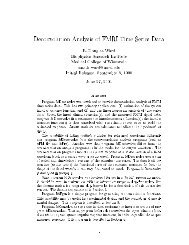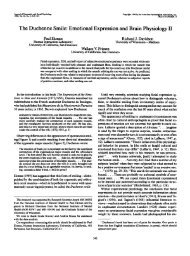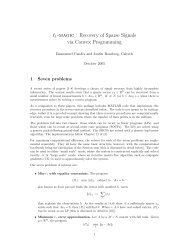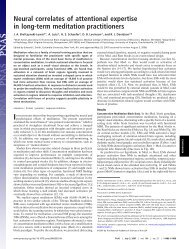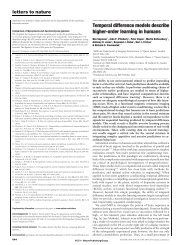View - Waisman Laboratory for Brain Imaging and Behavior
View - Waisman Laboratory for Brain Imaging and Behavior
View - Waisman Laboratory for Brain Imaging and Behavior
You also want an ePaper? Increase the reach of your titles
YUMPU automatically turns print PDFs into web optimized ePapers that Google loves.
this complexity was at least partly<br />
the reason why relatively few generalizability<br />
studies were being conducted.<br />
I decided to try to publicize,<br />
teach, <strong>and</strong> simplify generalizability<br />
theory <strong>for</strong> graduate students <strong>and</strong><br />
measurement practitioners. At<br />
about this time, with the assistance<br />
of Kane <strong>and</strong> Gillmore (<strong>and</strong> later<br />
Noreen Webb <strong>and</strong> Xiaohong Gao), I<br />
began an every-other-year training<br />
session on G theory <strong>for</strong> the AERA<br />
<strong>and</strong> NCME Annual Meetings.<br />
My first ef<strong>for</strong>t at writing a simpler<br />
treatment of G theory (Brennan,<br />
1977) was a paper that was<br />
rejected by a major journal- the editor<br />
described it as being “too<br />
propaedeutic.” Just about that time<br />
Jay Millman, who was then president<br />
of NCME, asked me to consider<br />
writing a monograph on generalizability<br />
theory <strong>for</strong> publication by<br />
NCME. With the encouragement of<br />
Michael Kane <strong>and</strong> David Jarjoura, I<br />
agreed, but, when I completed the<br />
monograph almost 3 years later,<br />
NCME was no longer interested in<br />
publishing it! ACT, however, did<br />
publish Elements of Generalizability<br />
Theory (Brennan, 1983).<br />
I had long felt that a simpler<br />
treatment of G theory was not<br />
enough to get the theory used more<br />
widely by practitioners. They also<br />
needed a computer program. So, at<br />
the same time I was writing Elements<br />
of Generalizability Theory, I<br />
was designing a computer program<br />
called GENOVA (Crick & Brennan,<br />
1983) that would be coordinated<br />
with the monograph. My computer<br />
skills were not adequate <strong>for</strong> programming<br />
GENOVA, however. That<br />
task was undertaken by Joe Crick, a<br />
colleague from graduate school at<br />
Harvard, who somehow managed to<br />
translate my math <strong>and</strong> h<strong>and</strong>written<br />
input-output layouts into workable<br />
FORTRAN code while serving as<br />
Director of the Computing Center at<br />
the University of Massachusetts,<br />
Boston.<br />
Several expositions of G theory<br />
were published in the late 1980s <strong>and</strong><br />
early 199Os, all of which are briefer<br />
<strong>and</strong> less dem<strong>and</strong>ing than Cronbach<br />
et al. (1972) or Brennan (1983,<br />
1992a). Shavelson, Webb, <strong>and</strong> Rowley<br />
(1989) provided a particularly<br />
readable journal article that summarizes<br />
G theory, <strong>and</strong> in the same<br />
year Feldt <strong>and</strong> Brennan (1989) de-<br />
voted about one third of their chapter<br />
on reliability to G theory. In<br />
1991, Shavelson <strong>and</strong> Webb published<br />
a relatively short monograph<br />
entitled Generalizability Theory: A<br />
Primer. Brennan (1992b) provided a<br />
very brief introduction intended primarily<br />
<strong>for</strong> classroom use.<br />
Interest in per<strong>for</strong>mance testing in<br />
the late 1980s led to a mini-boom in<br />
generalizability analyses <strong>and</strong> considerably<br />
greater publicity <strong>for</strong> G<br />
theory. It seemed evident to practitioners<br />
that G theory was eminently<br />
well-suited to analyzing scores from<br />
such tests. In particular, practitioners<br />
realized that underst<strong>and</strong>ing the<br />
results of a per<strong>for</strong>mance test necessitated<br />
grappling with two or more<br />
facets simultaneously -especially<br />
tasks <strong>and</strong> raters. The relevance of G<br />
theory in such contexts is especially<br />
well illustrated by Richard Shavelson<br />
<strong>and</strong> his colleagues in a series of<br />
presentations <strong>and</strong> articles involving<br />
science <strong>and</strong> mathematics per<strong>for</strong>mance<br />
assessments, in particular<br />
(see, e.g., Gao, Brennan, & Shavelson,<br />
1994; Shavelson, Baxter, &<br />
Gao, 1993; Shavelson, Baxter, &<br />
Pine, 1991, 1992). Also, Brennan<br />
<strong>and</strong> Johnson (1995) <strong>and</strong> Brennan<br />
(199613) consider some theoretical<br />
<strong>and</strong> applied issues in per<strong>for</strong>mance<br />
testing from the perspective of G<br />
theory.<br />
New assessments such as per<strong>for</strong>mance<br />
tests recently motivated<br />
Cronbach, Linn, Brennan, <strong>and</strong><br />
Haertel (1995) to state: “Assessments<br />
depart from traditional measurements<br />
in ways that require<br />
extensions <strong>and</strong> modifications of generalizability<br />
analysis. . . . Assessments<br />
pose problems that reach<br />
beyond available psychometric theory”<br />
(p. 1). The Cronbach et al.<br />
(1995) report <strong>and</strong> a recent journal<br />
article revision (Cronbach, Linn,<br />
Brennan, & Haertel 1997) suggest a<br />
number of problems that need to be<br />
researched, <strong>and</strong> they propose some<br />
recommended solutions. These articles<br />
emphasize the importance of estimates<br />
of absolute st<strong>and</strong>ard errors<br />
of measurement <strong>for</strong> many of the<br />
types of decisions that are typically<br />
made with per<strong>for</strong>mance assessments.<br />
Also, these articles urge that<br />
an analysis of error <strong>for</strong> group means<br />
explicitly recognizes that pupils are<br />
nested in classes <strong>and</strong> schools.<br />
Whether to treat pupils as fixed or<br />
r<strong>and</strong>om in such analyses is discussed<br />
in some detail (see, also,<br />
Brennan 1995a).<br />
In their 1972 monograph, Cronbach<br />
<strong>and</strong> his colleagues illustrated<br />
the applicability of G theory largely<br />
by reanalyzing some already published<br />
data in the psychology <strong>and</strong><br />
education literature. Since 1972, in<br />
addition to topics already cited in<br />
this overview, G theory has been<br />
used to study issues such as classroom<br />
teaching (e.g., Erlich & Borich,<br />
1979; Erlich & Shavelson, 1976);<br />
program evaluation (e.g., Gillmore,<br />
1983); the use of tables of specifications<br />
in educational testing (e.g.,<br />
Jarjoura & Brennan, 1982, 1983;<br />
Kolen & Jarjoura, 1984); counseling<br />
<strong>and</strong> development (Webb, Rowley, &<br />
Shavelson, 1988); setting per<strong>for</strong>mance<br />
st<strong>and</strong>ards (Brennan, 1995b);<br />
job per<strong>for</strong>mance (Webb, Shavelson,<br />
Kim, & Chen, 1989); neuroticism<br />
<strong>and</strong> coping with anger (Atkinson, &<br />
Violato, 1994); <strong>and</strong> aspects of physiology,<br />
including blood pressure<br />
(Llabre et al., 1988; Saab et al.,<br />
1992).<br />
Unfinished Work<br />
G theory has a protean quality.<br />
The procedures <strong>and</strong> even the issues<br />
take on a new <strong>for</strong>m in every<br />
context. G theory enables you to<br />
ask your questions better; what is<br />
most significant <strong>for</strong> you cannot be<br />
supplied from the outside. (Cronbach,<br />
1976, p. 199)<br />
In this sense, G theory is a continuous<br />
work in progress, <strong>and</strong> none<br />
of the research reviewed here can be<br />
deemed complete. Still, there are<br />
some important theoretical <strong>and</strong> statistical<br />
topics that clearly need to be<br />
addressed more fully than they<br />
have been, <strong>and</strong> there are potential<br />
areas of application where the theory<br />
has been largely unused as yet.<br />
Although G theory has been applied<br />
in a number of contexts, the<br />
coverage is not balanced <strong>and</strong> one<br />
might expect that after 25 years<br />
many more generalizability analyses<br />
would have been conducted than<br />
are reported in the literature. Most<br />
published generalizability analyses<br />
are in the education literature, perhaps<br />
because those who are most<br />
knowledgeable about G theory tend<br />
to be employed in colleges of education,<br />
educational testing companies,<br />
<strong>and</strong> related organizations. Clearly,<br />
Winter 1997 17




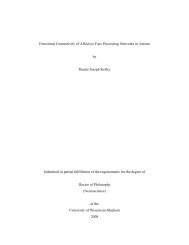
![[F-18]-L-DOPA PET scan shows loss of dopaminergic neurons](https://img.yumpu.com/41721684/1/190x146/f-18-l-dopa-pet-scan-shows-loss-of-dopaminergic-neurons.jpg?quality=85)
